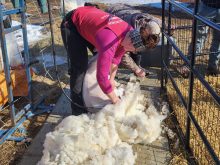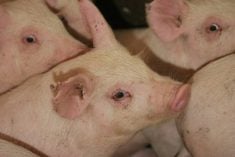Slaughter ready cattle began moving to American packing plants this week after the overturning of a March 2 temporary injunction that halted movement of live cattle.
News of an open border granted unanimously by a panel of three appeal court judges in the Ninth Circuit Court in Seattle, Washington, on July 14 was received as positive news with a caveat.
“We are not letting down our guard or our lobbying efforts as to regained trade with the U.S. under these new realities,” said Stan Eby, president of the Canadian Cattlemen’s Association.
Read Also

Charges laid after cattle theft
Saskatchewan RCMP lay two charges against a man after six cattle went missing.
The next court hearing for a permanent injunction is scheduled for July 27 in Billings, Montana. Industry leaders are preparing for a full day before judge Richard Cebull, who issued the temporary stop in Canadian cattle trade to the United States last March.
This hearing, requested by the U.S. cattle producer group R-CALF, wants to stop trade of live animals and meat, claiming Canada’s risk of BSE remains higher than the U.S.
Recent confirmation of a domestic case of BSE in the U.S. is expected to influence the court because on an international basis, Canada and the U.S. have the same disease status.
“R-CALF hasn’t accepted that yet,” Eby said.
There is concern that Cebull could rule in favour of a permanent ban.
“Nothing surprises me anymore. We are so used to getting whacked,” said Darcy Davis, chair of the Alberta Beef Producers.
If R-CALF wins, Canadian industry players say they hope the U.S. Department of Agriculture requests a stay so trade can continue, said Eby.
If the injunction is not granted,
R-CALF has indicated it will appeal for a hearing to the Supreme Court.
In a written statement, R-CALF chief executive officer Bill Bullard said the organization remains confident it can win July 27 and can demonstrate that USDA’s actions are premature and unjustified in permitting further trade with Canada.
Industry leaders also worry R-CALF might push harder for mandatory country of origin labelling or request a countervail duty because of the aid the Canadian government gave producers through direct payments or set-aside programs.
Effective the week of July 20, auctions held under the fed cattle set-aside program were suspended until further notice. Terms and conditions of the fed cattle and feeder cattle set-aside programs remain in effect and producers are asked to keep their cattle in the program until further changes are announced.
Meanwhile, only a few loads of fattened cattle are expected to move in the next week as Canadian exporters collect documentation and gather market ready animals.
Export requirements for cattle and bison younger than 30 months and other ruminants such as sheep and goats younger than 12 months were outlined in U.S. Department of Agriculture rules released at the end of 2004, naming Canada a minimum risk country for BSE.
However, no one is sure how many animals may be exported since Canada’s slaughter capacity has substantially increased in the last two years, said Kee Jim, producer and veterinarian from Okotoks, Alta.
With more competition in the marketplace, bidding for available animals could be intense with more enticing prices to keep cattle here.
“We have 20,000-25,000 (head) more slaughter capacity so what will the local packers bid?” said Jim.
Veterinarians are checking eligible cattle for proof of age through dentition and physical descriptions. Animals must move in sealed trucks and will be inspected when they arrive on U.S. soil.
Few feeder calves are expected to move right away because there are not many available at this time of year. Also, market heifers are not likely to be exported soon because they must be pregnancy checked before they can leave and few exporters wish to incur the added expense.

















